|
intro
sources
summary
references
back
|
Neutral Gas and Thermal Plasma in Saturn's Magnetosphere:
Implications for Measurements by the Cassini Ion Neutral Mass Spectrometer (INMS)
S. A. Ledvina
Introduction
Saturn's magnetosphere, like Jupiter's, contains numerous sources of neutral gas.
The neutral gas can become ionized and contribute to the thermal plasma and radiation
belt particle populations. In particular, sputtering by charged particle and meteoroid bombardment
of material from the rings and the surfaces of Saturn's icy moons is believed to create an extensive
neutral cloud of water molecules and water dissociation products in the inner magnetosphere that seeds
it with water product ions.
Titan acts as a source of both neutral gases and ions for the outer magnetosphere. Both neutral and ionized hydrogen and nitrogen tori surround Saturn near the orbit of Titan at about 20 Rs, and plumes of heavy ions from Titan may extend beyond Titan's orbit. The ion neutral mass spectrometer (INMS) onboard the Cassini Orbiter will measure neutral and ion thermal energy, densities and composition in at least the densest portions (>10^4 cm^-3 for neutrals, >10^-4 cm^-3 for ions) of these tori/clouds. This poster provides an overview of what is currently known about these tori, mostly from Voyager data and from models. INMS will provide opportunities to directly sample the rings, the icy satellites, and Titan's most extended atmospheres.
Our current picture of the neutral and plasma tori at Saturn are based on a series of Earth-based observations of Lyman alpha emission, and observations made by Pioneer and the Voyager missions. Neutral hydrogen and nitrogen clouds were found to exist in the outer magnetosphere, extending radially from about 8 Rs to 25 Rs and with a thickness of about 12 Rs. The mean densities of the hydrogen and nitrogen clouds were found to be about 20 cm^-3 and 6 cm^-3 respectively. Shemansky and Hall (1992) examined the Voyager UVS observations and found that the angular distribution of the hydrogen cloud was asymmetric with a higher concentration near the dusk side. The source material for each cloud was found to originate from Titan. Within the inner magnetosphere resonance-scattered Lyman alpha emissions provided evidence for a hydrogen atmosphere associated with Saturn's rings. This atmosphere is confined radially between 2-3 Rs with a thickness of about 0.4 Rs. The mean density was found to be about 400 cm^-3. In addition a neutral water torus has been inferred to exist near the rings and icy satellites, based on heavy ion observations in this region by both the Pioneer and the Voyager spacecraft.
Both the Pioneer and the Voyager spacecraft detected a heavy ion torus in the inner magnetosphere. The torus extends from about 10 Rs inward with a peak density of about 50 cm^-3. In addition, local density maxima were observed near the orbits of the icy satellites. The exact species of the ions in this region is undetermined, but they are thought to be primarily water group ions. Within the outer magnetosphere the Voyager spacecraft encountered several localized density enhancements. These enhancements appeared to contain low temperature heavy ions of mass 14 amu and possibly 28 amu. These enhancements can be identified as a plasma plume originating from Titan. This plume wraps itself around Saturn, forming a Titan plasma torus. (See the review articles by Scarf et al., 1984, and Schardt et al., 1984, for further details.)
Sources
Titan's Gas and Plasma Torus
Unlike the icy satellites, Titan possesses a substantial atmosphere and hence an ionosphere. The interaction of Titan's ionosphere with Saturn's outer magnetosphere results in Titan being both a source and a sink of magnetospheric neutrals and ions. The primary processes of Titan's plasma interaction are summarized in the figure below. These same types of processes are also at work near the icy satellites and rings, except that the exospheres start at their surfaces, and the background field and flow are less affected than at Titan.
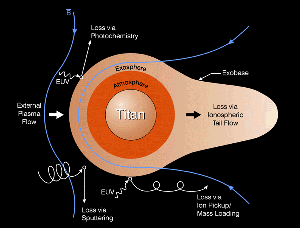
|
A schematic illustration of Titan's interaction with Saturn's magnetospheric plasma. The key processes that lead to neutrals and ions being removed from Titan and added to Saturn's magnetosphere are shown. The solid blue line represents the draping of Saturn's magnetic field around Titan's ionosphere. Click on image to enlarge.
|
Energetic ions may impact Titan's atmosphere where they sputter off neutral atoms or molecules. Neutrals may also be ejected from Titan as a result of photochemical reactions. These reactions may energize some of the neutrals beyond the escape speed of Titan. The ejected neutrals will begin to orbit Saturn, producing a neutral torus. The main components of this neutral torus are hydrogen and nitrogen.
Analysis of the Voyager ultraviolet spectrometer data by Shemansky and Hall (1992) found that the hydrogen torus was not axially symmetric, but had a strong local time dependence. This local time dependence was demonstrated by Ip (1996) to be the result of orbital perturbations of the hydrogen atoms by solar radiation pressure acting over the ionization lifetime of these neutrals. Solar radiation pressure changes the initial circular orbit of a neutral hydrogen atom into an elliptical orbit with an apogee located in the dawn direction. This effect results in a density cavity on the dawn side of Saturn and results in a hydrogen torus that extends radially inward on the dusk side of Saturn.
|
The global distribution of atomic hydrogen from the model of Ip (1996). The distribution of the hydrogen emitted from Titan is strongly influenced by the solar radiation pressure. The x-axis points in the direction of the sun. The negative y-axis points in the direction of the dawn side of Saturn. A density cavity is clearly visible on this side. In contrast the hydrogen density on the dusk side is spread from Titan's orbit radially inward towards Saturn. Click on image to enlarge.
|
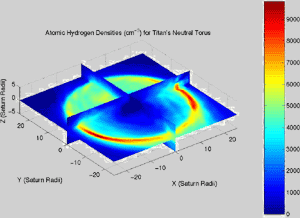
|
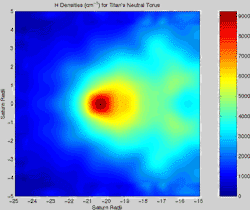
|
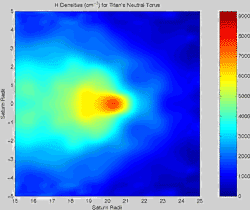
|
|
Cross sections of atomic hydrogen density (cm^-3) in the noon(left)-midnight(right) plane (xz-plane). From the model by Ip (1996). Click on images to enlarge.
|
Titan's nitrogen torus forms in a similar fashion as its hydrogen torus. The density distribution of the nitrogen torus depends strongly on the total emission rate, the initial velocity distribution of the out flowing neutrals and the ionization rate of the neutral nitrogen. Calculations by Ip (1992) suggest that the peak number density near the orbit of Titan can peak between 10-40 cm^-3 depending on the initial conditions. This value drops to around 0.1 cm^-3 in the Tethys-Dione region.
|
Cross sections of atomic nitrogen density (cm^-3). From the model by Ip (1992). Click on image to enlarge.
|
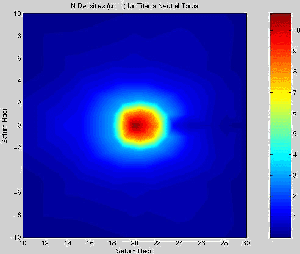
|
The atoms and molecules in Titan's neutral torus can be ionized and picked up by Saturn's magnetic field. This is just one process that can produce a plasma torus around Saturn. Another process contributing to Titan's plasma torus is Titan itself. Neutrals in Titan's atmosphere can be ionized by impact with Saturn's magnetospheric electrons or by solar extreme ultraviolet photons. Ions created at lower altitudes may outflow down the wake, while ions created at higher altitudes are picked up by the external plasma and magnetic field. These processes may lead to a Titan plasma plume which wraps around Saturn. As Titan orbits Saturn it may encounter plasma from this plume.
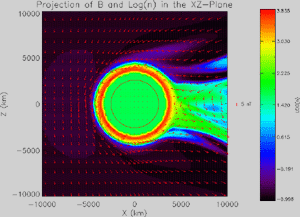
|
Projection of the magnetic field vectors and contours of the log of the number density from an updated version of the three-dimensional MHD model of Titan's interaction with Saturn's magnetospheric plasma by Ledvina and Cravens (1998). Ionospheric tail flow is evident as is the draping of the magnetic field. The circle represents Titan. Saturn's magnetospheric flow is from the left. The density shown below an altitude of about 700 km is an artifact from the contouring algorithm. Click on image to enlarge.
|
The Icy Satellites
A torus of neutral water molecules coexists with the icy satellites Enceladus, Tethys, Dione and Rhea, and Saturn's rings. Unlike Titan these satellites do not have a substantial atmosphere. The surface of these satellites interact directly with Saturn's magnetosphere. Bombardment of the satellites by ions present in Saturn's magnetosphere sputters off neutrals. Since the surface of these satellites is mostly water ice (see review by Cruikshank et al. 1984), the sputtered neutral should be mainly water. Most of these sputtered neutrals have sufficient energy to escape the gravitational fields of the small satellites. However, they do not have sufficient energy to escape the gravitational field of Saturn. These neutral co-orbit with the satellites forming a gravitationally bound toroidal atmosphere around Saturn. On average these neutrals make several orbits about Saturn before being ionized (via photons, electron impact or charge exchange) and picked-up by Saturn's magnetic field.
The results of the model of Johnson et al. (1989) show that the neutral water densities are highly peaked around the orbital location of the satellites. The water density is mainly confined to the orbital plane. Given this configuration, the satellites should interact with their respective neutral tori, reabsorbing some of the neutrals. Johnson et al. (1989) estimate that less than 10% of the sputtered neutrals will be reabsorbed by the satellite.
|
Contributions to the water density in the inner torus due to the satellites Enceladus, Tethys, Dione and Rhea. From the model of Johnson et al. (1989). Click on image to enlarge.
|
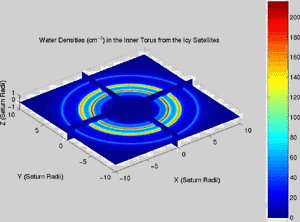
|
|
Cross section of the water density in the inner torus due to the satellites Enceladus, Tethys, Dione and Rhea. From the model of Johnson et al. (1989). Click on image to enlarge.
|
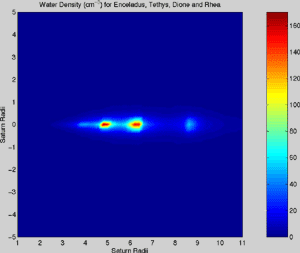
|
Ionization of the icy satellite neutral torus leads to the formation of an inner plasma torus. Like the densities in the neutral torus, the water ion densities peak around the orbital locations of the satellites. Johnson et al. (1989) concluded from their models that ions from the icy satellites could not account for all of the ion density observed in the inner regions of the magnetosphere. They infer that an additional source of neutrals was needed in the region to account for the difference, possibly ring erosion.
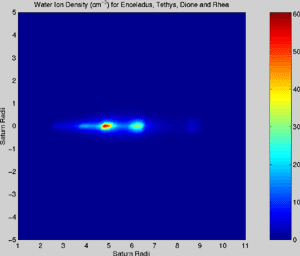
|
Contributions to the water ion density in the inner torus due to the satellites Enceladus, Tethys, Dione and Rhea (right). From the model of Johnson et al. (1989). Click on image to enlarge
|
The Rings
Saturn's rings are composed of many particle ranging in size from a few millimeters to about 5 m in radius. Most of these particles have icy surfaces, are are thought to be composed of mainly water. The rings cover a radial distance that extends from near the top of Saturn's atmosphere (1.11 Rs) out to about 8 Saturn radii. For radial distances from Saturn less than about 4 Rs, Pospieszalska and Johnson (1991) have suggested that micrometeorite erosion of the main rings may be a significant source of water molecules and water ions. The neutral densities produced by this process can be significant. Neutral density results from the model of Pospieszalska and Johnson show a peak density of about 4 x 10^4 cm^-3 located around a radial distance of 1.4 Rs. At low radial distances the cloud is compressed by Saturn's gravitational pull. The cloud expands as the gravitational field falls off at larger radial distances. The ring cloud is confined in the vertical direction, extending less than 1 Rs. This cloud may result in an injection of water molecules into Saturn's atmosphere and is though to be a source of some of the transient features observed in the rings.
|
Contours of water density through a cross section of the inner torus (r < 3.5 Rs) associated with Saturn's rings and including contributions from the satellites Enceladus, Tethys, Dione and Rhea. From the models of Johnson et al. (1989) and Pospieszalska and Johnson (1991). Click image to enlarge.
|
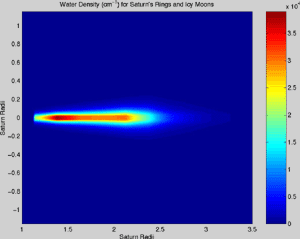
|
Ionization of the water within the ring cloud (photoionization, electron impact, and charge exchange) forms a heavy ion torus within the orbit of Enceladus (about 4 Rs). The plasma in this torus has a relatively low temperature. It will interact with the water neutral in the cloud and neutral hydrogen escaping from Saturn's atmosphere (see Richardson et al. 1986; Pospieszalska and Johnson, 1991). In these respects the plasma acts similar to ionospheric plasma. However, the structure and distribution of this plasma is typical of toroidal magnetospheric plasma (Pospieszalska and Johnson, 1991).
The plasma density results from the model of Pospieszalska and Johnson show a peak density of 3.5 x 10^4 cm^-3 at roughly the same radial distance as the peak neutral density (1.4 Rs). The magnetospheric fields dominate are more important to the ion dynamics then the gravitational force. This results in much less constriction of the plasma torus near Saturn. In addition the plasma expands less at larger radial distances then the neutral cloud does. There is also less spread out in the radial direction than the neutrals.

|
Contours of water ion density through a cross section of the inner torus (r < 3.5 Rs) associated with Saturn's rings and including contributions from the satellites Enceladus, Tethys, Dione and Rhea. From the model of Pospieszalska and Johnson (1991). Click on image to enlarge.
|
Beyond a radial distance of 2.3 Rs both the neutral and plasma densities begin to fall off. At this location the speed of the plasma particle corotating with the magnetosphere is larger than the escape speed of a neutral particle at this location. Once an ion at these distances is neutralized it escapes the Saturnian system (baring further ionization). This reduces the neutral density in this region and, hence, reduces the ion density because there are less neutrals to ionize. This process is efficient at removing debris from the region near Saturn and may be the determining factor in the location of the outer edge of the main ring Pospieszalska and Johnson, 1991.
The results of Pospieszalska and Johnson (1991) depend strongly on the initial energy distribution of the micrometeorites (which is not currently known). The results indicate that micrometeorite erosion of the main rings may increase the neutral density in the 2.3 Rs < r < 4 Rs region by two orders of magnitude over the icy satellite contribution (though this is unlikely). There are other possible sources of neutrals and ions that may make up the difference between the density observation of the inner tori and the results of the Johnson et al. (1989) model of the icy satellites, such as an active surface on Enceladus or E-ring particles (Pospieszalska and Johnson, 1991). Further observations by instruments onboard the Cassini spacecraft, such as the INMS, are needed to resolve this issue.
Summary
Several of the scientific objectives for Cassini relating to Saturn's magnetosphere are dependent on the neutral gas and plasma tori discussed here. Contributions by the INMS to the study of these objectives are listed in
table 1.
A picture of the neutral tori surrounding Saturn based on the models discussed above is shown below. The planned trajectory of the Cassini spacecraft through this region during its first year at Saturn is also shown. Predicted neutral and ion densities encountered along the orange segment of the trajectory are plotted as times series below. Hydrogen from the Titan torus is observed throughout most of the trajectory. This is not the case for the water ions and neutrals present in the icy satellite and rig tori. These species are only observed during a brief period when the spacecraft is close to Saturn.
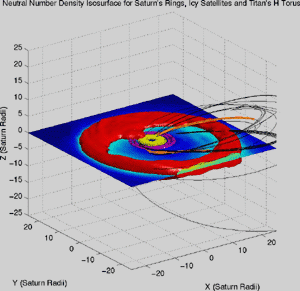
|
The modeled atomic hydrogen distribution in Saturn's magnetosphere is illustrated here as an isosurfaces showing the 4000 cm^-3 number density level (red), based on the model of Ip (1996). Also shown are the 60 cm^-3 (magenta) and 20 cm^-3 (yellow) levels for neutral water molecules associated with the icy satellites (Johnson et al., 1989) and the rings (Pospieszalska and Johnson, 1991) respectively. The planned trajectory of the Cassini spacecraft through this region during its first year at Saturn is also shown. Predicted densities encountered along the orange segment of the trajectory are plotted as times series below. Click on image to enlarge.
|
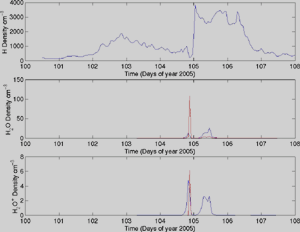
|
Time series plots of the modeled number density along the orange segment of the planned Cassini trajectory shown above. The modeled hydrogen number density associated with the Titan torus based on the model of Ip (1996) is shown in the top panel. The middle panel shows the Johnson et al. (1989) and Pospieszalska and Johnson (1991) number density of the neutral water ions associated with the icy satellites (blue) and the rings (red). The water ion density associated with the icy satellites (blue) and the rings (red), calculated by Johnson et al., from the neutral water densities and expected ionization rates, is shown in the bottom panel. Click on image to enlarge.
|
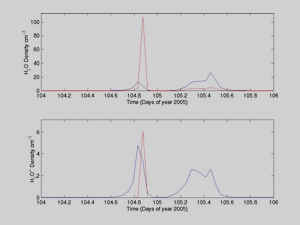
|
Expanded Time series plots of the modeled number density of the neutrals and ions during the icy satellites and ring tori encounter shown above. The top panel shows the Johnson et al. (1989) and Pospieszalska and Johnson (1991) number density of the neutral water ions associated with the icy satellites (blue) and the rings (red). The water ion density associated with the icy satellites (blue) and the rings (red), calculated by Johnson et al., from the neutral water densities and expected ionization rates, is shown in the bottom panel. Click on image to enlarge.
|
Neutral gas and thermal plasma is thought to exist in the magnetosphere of Saturn and to have substantial densities at some locations. The picture of neutral and plasma tori presented in this poster is based on a rather small set of data and extensive modeling. A fresh infusion of data from the Cassini mission will be needed to either confirm it or modify it. The Cassini INMS will be able to carry out critical, and unique, in situ measurements of the neutral gas and its composition in the magnetosphere, and to assist in the characterization of the thermal plasma by measuring low energy ions and their composition.
A movie (in AVI format) of the neutral tori as viewed by the Cassini spacecraft during Saturn orbit insertion (SOI) can be found
here:
References
Barbosa, D. D., 'Titan's atomic nitrogen torus:inferred properties and consequences for the Saturnian aurora', Icarus, 72, 53, 1987.
Cruikshank, D. P., J. Veverka and L. A. Lebofsky, 'Satellites of Saturn: Optical Properties', in Saturn, eds. T. Gehrels and M. S. Matthews, pp. 640-667, Univ. of Arizona Press, Tucson, 1984.
Eviatar, A., Yu. Mekler and M. Podolak, 'Titan's Gas and Plasma Torus', J. Geophys. Res., 88, 833, 1983.
Ip, W.-H., 'The Ring Atmosphere of Saturn: Monte Carlo Simulation of Ring Source Models', J. Geophys. Res., 89, 8843, 1984.
Ip, W.-H., 'Plasma Interaction of Titan with the Saturnian Magnetosphere: A Review of Critical Issues', Proceedings of the ESLAB Symposium on Titan, Toulouse, France, 1991.
Ip, W.-H., 'The Nitrogen Tori of Titan and Triton', Adv. Space Res, 12 (8)73, 1992.
Ip, W.-H., 'The Asymmetric Distribution of Titan's Atomic Hydrogen Cloud as a Function of Local Time', Astrophys. J., 457, 922, 1996.
Johnson, R. E., M. K. Pospieszalska, E. C. Sittler, Jr., A. F. Cheng, L. J. Lanzerotti and E. M. Sieveka, 'The Neutral Cloud and Heavy Ion Inner Torus at Saturn', Icarus, 77, 311, 1989.
Ledvina, S. A. and T. E. Cravens, 'A Three-Dimensional MHD Model of Plasma Flow Around Titan', Planet. Space Science, 46, 1175, 1998
Pospieszalska, M. K. and R. E. Johnson, 'Micrometeorite Erosion of the Main Rings as a Source of Plasma in the Inner Saturnian Plasma Torus', Icarus, 93, 45, 1991.
Richardson, J. D., A. Eviatar, and G. L. Siscoe, 'Satellite Tori at Saturn', J. Geophys. Res., 91, 8749, 1986.
Scarf, F. L., L. A. Frank, D. A. Gurnett, L. J. Lanzerotti, A. Lazarus, and E. C. Sittler, Jr., 'Measurements of Plasma, plasma waves, and suprathermal charged particles in Saturn's inner magnetosphere', in Saturn, eds. T. Gehrels and M. S. Matthews, pp. 318-353, Univ. of Arizona Press, Tucson, 1984
Schardt, A. W., K. W. Behannon, R. P. Lepping, J. F. Carbary, A. Eviatar and G. L. Siscoe, 'The Outer Magnetosphere', in Saturn, eds. T. Gehrels and M. S. Matthews, pp. 416-459, Univ. of Arizona Press, Tucson, 1984.
Shemansky, D. E. and D. T. Hall, 'The distribution of atomic hydrogen in the magnetosphere of Saturn', J. Geophys. Res., 97, 4143, 1992.
Sittler, E. C., Jr., J. D. Scudder, and H. S. Bridge, 'Distribution of neutral gas and dust near Saturn', Nature, 292, 711, 1981.
|
|



